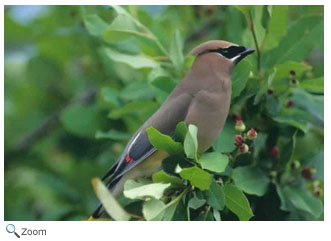Aves - All About Birds
 Birds have backbones and feathers. Like mammals, birds are warm-blooded, or endothermic. They can live in warm and cold climates. Most birds fly, but there are some species, like the penguins, that swim. Others, like the ostrich, are ground-dwelling.
Birds have backbones and feathers. Like mammals, birds are warm-blooded, or endothermic. They can live in warm and cold climates. Most birds fly, but there are some species, like the penguins, that swim. Others, like the ostrich, are ground-dwelling.
Birds have bills and no teeth, and they lay eggs. They have four parts to their bodies: a head, a neck, a torso, and a tail. They have light, hollow bones that make flight easier, and they have two legs and two wings.
There are about 9,600 species. Scientists believe that birds are descended from dinosaurs. There are two subclasses of birds: Archaeornithes and Neornithes. Archaeornithes are, or were, primitive birds from the Jurassic or early Cretaceous periods. The Neornithes subclass includes all of the birds alive today.
Educational Resources
Bird Orders
 Accipitriformes (hawks, eagles)
Accipitriformes (hawks, eagles)
 Anseriformes (ducks, geese, swans)
Anseriformes (ducks, geese, swans)
 Apodiformes (hummingbirds, swifts)
Apodiformes (hummingbirds, swifts)
 Bucerotiformes (hornbills, hoopoes)
Bucerotiformes (hornbills, hoopoes)
 Caprimulgiformes (nightbirds)
Caprimulgiformes (nightbirds)
 Cathartiformes (New World Vultures)
Cathartiformes (New World Vultures)
 Charadriiformes (shorebirds)
Charadriiformes (shorebirds)
 Ciconiiformes (herons, storks, vultures)
Ciconiiformes (herons, storks, vultures)
 Coliiformes (mousebirds)
Coliiformes (mousebirds)
 Columbiformes (doves, pigeons)
Columbiformes (doves, pigeons)
 Coraciiformes (kingfishers)
Coraciiformes (kingfishers)
 Cuculiformes (cuckoos, hoatzins)
Cuculiformes (cuckoos, hoatzins)
 Falconiformes (falcons)
Falconiformes (falcons)
 Galliformes (turkeys, pheasants, quails)
Galliformes (turkeys, pheasants, quails)
 Gaviiformes (loons)
Gaviiformes (loons)
 Gruiformes (coots, cranes, rails)
Gruiformes (coots, cranes, rails)
 Passeriformes (perching birds)
Passeriformes (perching birds)
 Pelecaniformes (pelicans, boobies)
Pelecaniformes (pelicans, boobies)
 Phoenicopteriformes (flamingos)
Phoenicopteriformes (flamingos)
 Piciformes (woodpeckers, toucans)
Piciformes (woodpeckers, toucans)
 Podicipediformes (grebes)
Podicipediformes (grebes)
 Procellariiformes (albatrosses, fulmars)
Procellariiformes (albatrosses, fulmars)
 Psittaciformes (parrots, parakeets)
Psittaciformes (parrots, parakeets)
 Sphenisciformes (penguins)
Sphenisciformes (penguins)
 Strigiformes (owls)
Strigiformes (owls)
 Struthioniformes (ostriches, kiwis)
Struthioniformes (ostriches, kiwis)
 Tinamiformes (tinamous)
Tinamiformes (tinamous)
 Trogoniformes (trogons)
Trogoniformes (trogons)






